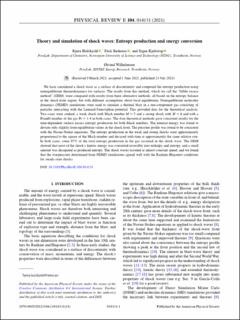| dc.contributor.author | Hafskjold, Bjørn | |
| dc.contributor.author | Bedeaux, Dick | |
| dc.contributor.author | Kjelstrup, Signe | |
| dc.contributor.author | Wilhelmsen, Øivind | |
| dc.date.accessioned | 2021-09-27T13:03:11Z | |
| dc.date.available | 2021-09-27T13:03:11Z | |
| dc.date.created | 2021-08-16T08:45:50Z | |
| dc.date.issued | 2021 | |
| dc.identifier.issn | 2470-0045 | |
| dc.identifier.uri | https://hdl.handle.net/11250/2783786 | |
| dc.description.abstract | We have considered a shock wave as a surface of discontinuity and computed the entropy production using nonequilibrium thermodynamics for surfaces. The results from this method, which we call the “Gibbs excess method” (GEM), were compared with results from three alternative methods, all based on the entropy balance in the shock-front region, but with different assumptions about local equilibrium. Nonequilibrium molecular dynamics (NEMD) simulations were used to simulate a thermal blast in a one-component gas consisting of particles interacting with the Lennard-Jones/spline potential. This provided data for the theoretical analysis. Two cases were studied, a weak shock with Mach number M ≈ 2 and a strong shock with M ≈ 6 and with a Prandtl number of the gas Pr ≈ 1.4 in both cases. The four theoretical methods gave consistent results for the time-dependent surface excess entropy production for both Mach numbers. The internal energy was found to deviate only slightly from equilibrium values in the shock front. The pressure profile was found to be consistent with the Navier-Stokes equations. The entropy production in the weak and strong shocks were approximately proportional to the square of the Mach number and decayed with time at approximately the same relative rate. In both cases, some 97% of the total entropy production in the gas occurred in the shock wave. The GEM showed that most of the shock’s kinetic energy was converted reversibly into enthalpy and entropy, and a small amount was dissipated as produced entropy. The shock waves traveled at almost constant speed, and we found that the overpressure determined from NEMD simulations agreed well with the Rankine-Hugoniot conditions for steady-state shocks | en_US |
| dc.language.iso | eng | en_US |
| dc.publisher | American Physical Society | en_US |
| dc.rights | Navngivelse 4.0 Internasjonal | * |
| dc.rights.uri | http://creativecommons.org/licenses/by/4.0/deed.no | * |
| dc.title | Theory and simulation of shock waves: Entropy production and energy conversion | en_US |
| dc.type | Peer reviewed | en_US |
| dc.type | Journal article | en_US |
| dc.description.version | publishedVersion | en_US |
| dc.source.volume | E104 | en_US |
| dc.source.journal | Physical review. E | en_US |
| dc.source.issue | 1 | en_US |
| dc.identifier.doi | 10.1103/PhysRevE.104.014131 | |
| dc.identifier.cristin | 1926147 | |
| dc.relation.project | Norges forskningsråd: 262644 | en_US |
| dc.source.articlenumber | 014131 | en_US |
| cristin.ispublished | true | |
| cristin.fulltext | original | |
| cristin.qualitycode | 1 | |

